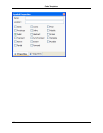
Code Templates
Code templates are pre-defined units of code that you can use to automate the creation of common code
elements, like a standard class implementation or design patterns. You can create templates for a whole
file or multiple files. Templates can contain substitution parameters that are replaced when the template is
instantiated—when a new element is created from that template. Some parameters are replaced with cal-
culated or pre-defined values, like date or author. If a value is not known, you will be prompted for a value
when the template is instantiated.
Code templates are composed of one or more template source files and a metadata file providing addi-
tional information, like the name of the template, a description of the template, prompts for substitution
parameters, and default values for substitution parameters. The following is an example of a single file
source template. The items surrounded by dollar signs ($) are the substitution parameters.
/*
* $copyright$
*/
package $package$;
/**
* @author $author$
* @version $version$
*/
public class $safeitemname$ {
/**
* Default constructor.
*/
public $safeitemname$(){
}
}
Templates can be organized into Categories to make them easier to manage. The templates shipped with
SlickEdit® Core are organized into categories by language and then by purpose. Use the Template Man-
ager dialog to add, edit, and delete user templates. The Template Manager dialog is accessed by clicking
File → SlickEdit Template Manager.
Instantiating a Template
You can add an item to your current project by clicking File → New Item from SlickEdit Template. If you
want to create a new item from a template without adding it to your current project, then click File → New
Item from SlickEdit Template. The Add New Item dialog box is shown below.
Figure 6.11. Add New Item Dialog
Instantiating a Template
103


















